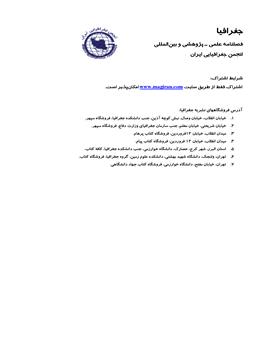The strategy of protecting and sustainable development of Tehran's frontage, with emphasis on assessing its social and cultural impact
Subject Areas :
1 -
2 -
3 -
Keywords: Frontage Sustainable Development Strategies Metropolis Tehran ,
Abstract :
Tehran's territory is about 23 cities, 237 villages and hundreds of activities, covering a total of about 2 million people, which, along with national conditions, continues to attract immigrants, population growth and sustainability. Spread of official and informal settlements if we ignore the harassment of the northern part of Tehran, the southern zone is the focus of the poor and dense lives that seems to be the mechanism of civil disarmament of urban and regional development programs, Acceptance of this type of residence has made. In this article, referring to the studies and the secondary data collected in the field of social and cultural issues of the Tehran metropolitan area (especially the social and cultural impact assessment of the comprehensive plan of privacy) and SWOT analysis of about 30 experts in this area, summing up Challenges and socio-cultural issues of Tehran metropolitan area, the strategies of macroeconomic stability and sustainable development are based on the assessment of the socio-cultural impact of privacy in Tehran.
1. ابراهيم¬پور، فرشاد (1389)، حريم سبز براي كنترل محدوده حريم شهرها، شوراها، ماهنامه اطلاع¬رساني، آموزشي و پژوهشي، شماره پنجم- شهريور ماه؛
2. اشرفي، شهني، اقبال (1389)، چالش¬ها و رويكردها در مديريت حريم شهري، شوراها، ماهنامه اطلاع¬رساني، آموزشي و پژوهشي، شماره پنجم- شهريور ماه؛
3. بشیری، عباس؛ براتی علی¬اکبر؛ پوررحیم، مریم (1390)، شرایط فنی و ضوابط قانونی انواع حریم در حقوق کاربردی ایران، تهران؛
4. پورجليل، نازيلا (1390)، حومه¬گرايي نوين چيست؟ شهر و ساختمان، سال نهم، شهريور و مهر 1390؛
5. پیرز، جان. ای ریچارد بی رابینسون ( 1383)، مدیریت راهبردی (برنامه¬ریزی، اجرا، کنترل)، ترجمه محمود حسینی، چاپ سوم، انتشارات سمت، تهران؛
6. حکمت¬نیا، حسن و میرنجف موسوی (1385)، کاربرد مدل در جغرافیا با تاکید بر برنامه¬ریزی شهری و ناحیه¬ای، انتشارات علم نوین، یزد؛
7. رحيم¬پور، جواد (1390)، گسترش شيب اجتماعي شهر تهران به حريم پايتخت، شهر و ساختمان، سال نهم، شهريور و مهر1390؛
8. رحيم¬پور، جواد (1390)، حفاظت، ماموريت اصلي سازمان متولي كمربند سبز، شهر و ساختمان، سال نهم، شهريور و مهر1390؛
9. روستا سكه رواني، مجيد (1382)، نقد و ارزيابي مطالعات جغرافيايي در طرحهاي توسعة شهري؛ مورد: شيراز. پايان¬نامة كارشناسي ارشد. دانشگاه شهيد بهشتي، دانشكدة علوم زمين. گروه جغرافيا؛
10. زیاری، کرامت¬اله (1383)، مکتب¬ها، نظریه¬ها و مدل¬های برنامه¬ریزی منطقه¬ای، انتشارات دانشگاه یزد، یزد؛
11. سالاري، محمد (1390)، حريم شهر تهران، فصلنامه شهر و ساختمان،سال نهم، شهريور و مهر 1390؛
12. سرور، رحيم (1389)، بررسي روند تحولات و آينده¬نگري گسترش سكونتگاههاي غيررسمي در منطقه شهري تهران،فصلنامه هفت شهر، شركت عمران و بهسازي شهري ايران؛
13. سرور، رحيم (1390)، آينده شهري در قرن 21، انتشارات دانشگاه آزاد اسلامي؛
14. فرشیدی، حسین؛ اسماعیلی، اعظم (1389)، اهمیت حریم شهرها، فصلنامه شوراها، ١٣٨٩؛
15. فرشيدي، حسين (1389)، اهميت حريم شهرها، شوراها، ماهنامه اطلاع¬رساني، آموزشي و پژوهشي، شماره پنجم- شهريور ماه؛
16. كارگر، بهمن؛ سرور، رحيم (1390)، شهر، حاشيه و امنيت اجتماعي، انتشارات سازمان جغرافيايي نيروهاي مسلح؛
17. كاظميان، غلامرضا (1390)، خوش¬بين به برنامه بدبين به اجرا، متن مصاحبه، فصلنامه شهر و ساختمان، سال نهم، شهريور و مهر 1390؛
18. مددي، جواد (1379)، برنامه¬ريزي فضايي- كالبدي بافتهاي خودرو. نمونه: محلة شهر سيلاب شهر تبريز. دانشگاه تهران، دانشكدة هنرهاي زيبا، گروه شهرسازي؛
19. مهندسان مشاور طرح و كاوش (1390)، پيشنهاد نظام اجرايي و قانوني مديريت حريم پاتخت و تعيين حدود و مرزهاي نهايي آن،مركز مطالعات و برنامه¬ريزي شهر تهران؛
20. نجف¬آبادي¬پور، قاسميان (1380)، برنامهريزي راهبردي ارتقاء كيفيت محيط شهري در سكونتگاههاي حاشية شهر با به¬كارگيري روش تحليل نواحي اجتماعي، پايان¬نامة كارشناسي ارشد. دانشگاه شهيد بهشتي، دانشكدة معماري و شهرسازي؛
21. هاشمي، سيدمناف (1389)، بررسي جرايم و تخلفات واقع در حريم و ضمانت اجراي آن با تاكيد بر حريم تهران، شوراها، ماهنامه اطلاع¬رساني، آموزشي و پژوهشي، شماره پنجم- شهريور ماه؛
22. يزداني، جمشيد، 1389، حريم در مديريت شهري، شوراها، ماهنامه اطلاع¬رساني، آموزشي و پژوهشي، شماره پنجم- شهريور ماه؛
23. Azfar , asad & rahman, oun(2004), Housing the urban poor. Http://www.acumenfound. Org;
24. Amin, S. H.; Razmi, J. and Zhang, G., (2011), Supplier selection and order allocation based on fuzzy SWOT analysis and fuzzy linear programming, Expert Systems with Applications, 38 (1), 334-342;
25. Department for international infrastructure and urban development. (2002), Key sheets for pro-poor infrastructure provision. www. Dfid.gov.uk & www. Odi.org/keysheets/;
26. Caves, Roger (2005), Encyclopedia of the City, Routledge;
27. karl, gunter (2000), 21Human settlement statistics. United nations center for human settlement, (UNCHS).Nairobi june.8-9;
28. kapoor, muditatet. All (2004), Location & welfare in cities. Development research group. World Bank. Washington dc, 20433, USA.PP1-3.http://econ. Wordbank.org;
29. Marshall, F., Waldman, L., MacGregor, H., Mehta, L. and Randhawa, P. (2009), On the Edge of Sustainability: Perspectives on Peri-urban Dynamics, STEPS Working Paper 35, Brighton: STEPS Centre;
30. OSCE (MISSION IN COSOVO), (2003), WORKING Regional roundtable on formalizing informal settlements of roma & athre vulnerable groups20. 31October, prishtine/ prestina, cosovo, pp1-9;
31. Pitzl, Gerald (2004), Encyclopedia of Human Geography, Greenwood Publication;
32. http:// Aftab. ir/articales/social/urban;
33. http://eshiraz.ir/shahr sazi/fa.com;
34. http://fa Wikipedia.org;
35. http://mahdi 3006.blogfa. com;
36. http://rasht.ir/;
37. http://www.shahrsakt.mihanblog. Com.


